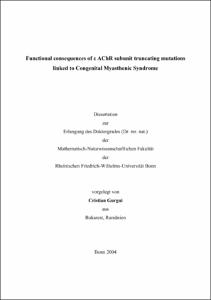Gurgui, Cristian: Functional consequences of ε AChR subunit truncating mutations linked to Congenital Myasthenic Syndrome. - Bonn, 2005. - Dissertation, Rheinische Friedrich-Wilhelms-Universität Bonn.
Online-Ausgabe in bonndoc: https://nbn-resolving.org/urn:nbn:de:hbz:5N-05333
Online-Ausgabe in bonndoc: https://nbn-resolving.org/urn:nbn:de:hbz:5N-05333
@phdthesis{handle:20.500.11811/2275,
urn: https://nbn-resolving.org/urn:nbn:de:hbz:5N-05333,
author = {{Cristian Gurgui}},
title = {Functional consequences of ε AChR subunit truncating mutations linked to Congenital Myasthenic Syndrome},
school = {Rheinische Friedrich-Wilhelms-Universität Bonn},
year = 2005,
note = {Congenital myasthenic syndromes (CMS) are inherited disorders due to presynaptic, synaptic, or postsynaptic defects of neuromuscular transmission. Some previously described kinships with typical signs of postsynaptic CMS showed a marked deficiency of nicotinic acetylcholine receptors (AChRs) as well as biochemical and morphological changes at the neuromuscular junctions (Shen et al., 2003; Engel et al., 1996a,b; Ohno et al., 1997; Ohno et al., 1998a; Abicht et al., 1999; Middleton et al., 1999; Croxen et al., 1999; Sieb et al., 2000a,b; Shen et al., 2002). Recently, five truncating (epsilon911delT, epsilon1030delC, epsilon1101insT, epsilon1206ins19, and epsilon1293insG) and one missense mutation (epsilonV448L) in the muscular AChR epsilon-subunit gene (CHRNE) were identified in patients with CMS symptoms (Engel et al., 1996a; Ohno et al., 1998b; Sieb et al., 2000a,b). We introduced the six mutations into the human epsilon-subunit and investigated their functional consequences by the means of patch-clamp technique after co-expression with human alpha, beta and delta-subunits in HEK 293 cells.
Whole-cell recordings revealed that with the exception of epsilonV448L AChR all mutants exhibited altered biophysical properties, with acceleration of the macroscopic current decay and enhanced degree of desensitization, similar to -epsilon receptor. Furthermore, the receptors carrying the truncating mutations showed a significantly reduced current density. Mutant epsilonV448L exhibited biophysical properties similar to those of wt receptor.
Single-channel recordings revealed that mutants epsilon911delT and epsilon1101insT opened with brief and isolated events, similarly to -epsilon receptor. In contrast, mutant epsilon1030delC switched between two distinct gating modes, one resembling the gating pattern of wt AChR, with bursts of single-channel openings and a second one with very low probability of opening, as observed with -epsilon receptor. Mutant epsilonV448L exhibited gating kinetics that were similar to wt receptor.
From whole-cell- and single-channel studies, we conclude that the missense mutation epsilonV448L is very unlikely to alter the receptor function significantly. Only mutation epsilon911delT, located at the end of the third transmembrane domain, completely prevented formation of functional receptors at the neuromuscular junction. All the other mutations result in functional channels, however, with altered biophysical properties and reduced current density. Furthermore, our data suggest that the low open probability observed with the receptors carrying the epsilon-truncating mutations is most probably the main factor that results in the drastic reduction of their current density. The changes in receptor function associated with the truncating mutations are very likely to result in the defects in neuromuscular transmission observed in postsynaptic CMS.},
url = {https://hdl.handle.net/20.500.11811/2275}
}
urn: https://nbn-resolving.org/urn:nbn:de:hbz:5N-05333,
author = {{Cristian Gurgui}},
title = {Functional consequences of ε AChR subunit truncating mutations linked to Congenital Myasthenic Syndrome},
school = {Rheinische Friedrich-Wilhelms-Universität Bonn},
year = 2005,
note = {Congenital myasthenic syndromes (CMS) are inherited disorders due to presynaptic, synaptic, or postsynaptic defects of neuromuscular transmission. Some previously described kinships with typical signs of postsynaptic CMS showed a marked deficiency of nicotinic acetylcholine receptors (AChRs) as well as biochemical and morphological changes at the neuromuscular junctions (Shen et al., 2003; Engel et al., 1996a,b; Ohno et al., 1997; Ohno et al., 1998a; Abicht et al., 1999; Middleton et al., 1999; Croxen et al., 1999; Sieb et al., 2000a,b; Shen et al., 2002). Recently, five truncating (epsilon911delT, epsilon1030delC, epsilon1101insT, epsilon1206ins19, and epsilon1293insG) and one missense mutation (epsilonV448L) in the muscular AChR epsilon-subunit gene (CHRNE) were identified in patients with CMS symptoms (Engel et al., 1996a; Ohno et al., 1998b; Sieb et al., 2000a,b). We introduced the six mutations into the human epsilon-subunit and investigated their functional consequences by the means of patch-clamp technique after co-expression with human alpha, beta and delta-subunits in HEK 293 cells.
Whole-cell recordings revealed that with the exception of epsilonV448L AChR all mutants exhibited altered biophysical properties, with acceleration of the macroscopic current decay and enhanced degree of desensitization, similar to -epsilon receptor. Furthermore, the receptors carrying the truncating mutations showed a significantly reduced current density. Mutant epsilonV448L exhibited biophysical properties similar to those of wt receptor.
Single-channel recordings revealed that mutants epsilon911delT and epsilon1101insT opened with brief and isolated events, similarly to -epsilon receptor. In contrast, mutant epsilon1030delC switched between two distinct gating modes, one resembling the gating pattern of wt AChR, with bursts of single-channel openings and a second one with very low probability of opening, as observed with -epsilon receptor. Mutant epsilonV448L exhibited gating kinetics that were similar to wt receptor.
From whole-cell- and single-channel studies, we conclude that the missense mutation epsilonV448L is very unlikely to alter the receptor function significantly. Only mutation epsilon911delT, located at the end of the third transmembrane domain, completely prevented formation of functional receptors at the neuromuscular junction. All the other mutations result in functional channels, however, with altered biophysical properties and reduced current density. Furthermore, our data suggest that the low open probability observed with the receptors carrying the epsilon-truncating mutations is most probably the main factor that results in the drastic reduction of their current density. The changes in receptor function associated with the truncating mutations are very likely to result in the defects in neuromuscular transmission observed in postsynaptic CMS.},
url = {https://hdl.handle.net/20.500.11811/2275}
}






